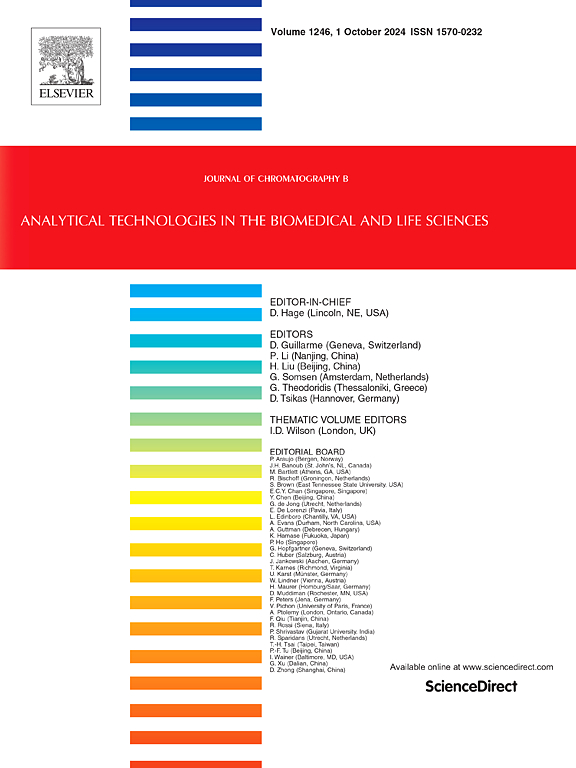Simultaneous analysis of 203 drugs of abuse and metabolites in urine samples using liquid chromatography–tandem mass spectrometry
IF 2.8
3区 医学
Q2 BIOCHEMICAL RESEARCH METHODS
引用次数: 0
Abstract
The issue of drug abuse is increasingly becoming a significant concern worldwide. However, the simultaneous detection of a wide spectrum of drug of abuse (DOA), especially in biofluids, is challenging due to their diverse and varied physicochemical properties and matrix effects. Herein, we have developed a liquid chromatography-tandem mass spectrometry (LC-MS/MS) method for simultaneous detection of 203 DOAs, including amphetamines, opiates, cathinones, phencyclidines, synthetic cannabinoids, cocaine, and metabolites, in 100 μL of urine. A mass analysis was performed using multiple reaction monitoring mode with an electrospray ionization source. The run time of the developed method was 16 min. Two sample preparation methods were compared for urine samples: enzymatic hydrolysis followed by either dilution or QuEChERS. Both methods demonstrated good linearity and low matrix effects; however, the dilution method showed superior accuracy and precision. Method validation was conducted to assess the efficacy of the developed method. The LC-MS/MS method with the dilution method demonstrated good linearity with the coefficients of determination (R2) above 0.99 for 200 compounds. The limit of quantification (LOQ) ranged from 0.1 to 20.0 ng/mL. The inter-day precision was below 20 % for all 203 compounds, with a bias of ±20 % for 198 compounds. This method was successfully applied to 40 real urine samples. The developed method allows the simultaneous separation and detection of a variety of DOAs with diverse physicochemical properties in a small amount of urine. Furthermore, the technique could be adapted to fit the practical requirements of forensic investigations, thereby enhancing its effectiveness and reliability.
求助全文
约1分钟内获得全文
求助全文
来源期刊

Journal of Chromatography B
医学-分析化学
CiteScore
5.60
自引率
3.30%
发文量
306
审稿时长
44 days
期刊介绍:
The Journal of Chromatography B publishes papers on developments in separation science relevant to biology and biomedical research including both fundamental advances and applications. Analytical techniques which may be considered include the various facets of chromatography, electrophoresis and related methods, affinity and immunoaffinity-based methodologies, hyphenated and other multi-dimensional techniques, and microanalytical approaches. The journal also considers articles reporting developments in sample preparation, detection techniques including mass spectrometry, and data handling and analysis.
Developments related to preparative separations for the isolation and purification of components of biological systems may be published, including chromatographic and electrophoretic methods, affinity separations, field flow fractionation and other preparative approaches.
Applications to the analysis of biological systems and samples will be considered when the analytical science contains a significant element of novelty, e.g. a new approach to the separation of a compound, novel combination of analytical techniques, or significantly improved analytical performance.
 求助内容:
求助内容: 应助结果提醒方式:
应助结果提醒方式:


